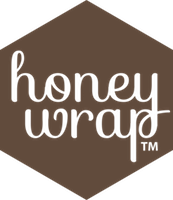FAQ
How do I care for my Honeywrap?
Brush off crumbs as you would a bread-board ( Ingredients beeswax, tree resin and jojoba are similar to ingredients used for a bread board). As needed wash with cold water and an eco detergent. Cold water provides a harder surface to wipe off. Warm water reduce the longevity of your wrap. Pat dry and reuse.
Despite strongly smelling of beeswax initially, this does not pass onto your food. The fragrance diminishes as the Honeywrap is used and washed over the first few weeks.
Beeswax, tree resin and jojoba are natural preservatives. The organic cotton infused with this mix allows your food to breathe and therefore last longer. The beeswax blend combines to create a tacky cloth which can be shaped around food and dishes to seal in goodness. By firmly pressing the Honeywrap around your food or bowl the warmth of your hands activates the mixture and the cloth will stick to itself.
Honeywraps are made from natural ingredients that respond to their environment. They will feel different depending on the temperature. If it is warmer they typically feel softer if colder they may feel harder and not as tacky. Honeywraps will soften and melt if temperatures get to 60 degrees. Room temperature does not usually reach this (unless you are in the Sahara) but be aware on hot days surfaces in direct sunlight can reach this. Wait for your food to cool before using your Honeywrap. Don't put in the oven, dishwasher or microwave. They will create a small mess!
With proper care your Honeywrap should last up to a year. Over time and use the tackiness of your wrap will reduce, however they can still work effectively to wrap food. You may need to hold more firmly and slightly longer when molding over a bowl.
If you prefer your Honeywrap to look pristine you will need to keep it away from some foods. For example cheeses and breads are fine, but some sauces will stain your Honeywrap – this does not affect the effectiveness of your Honeywrap. Your honeywrap is made from fabric so over time it may fray. You can use sewing scissors to trim frayed edges if you wish. Your Honeywrap can also be refreshed by hanging out in sunlight for short periods.
Your wraps work well with a huge variety of food and vegetables, cheeses, breads and leftovers. They allow the food to breathe, rather than sweat so really do keep your food fresh. Try the smalls ( 18 x 20 cm) with avocados, cucumbers, cabbage, onions, nuts etc. Be amazed. The medium (27 x 29 cm) and larger ( 33 x 33 cm) sizes work well with cheeses (avoid those cracking ends on your cheddar), leftovers, breads, salads, platters, melons. It is probably easier to say which foods to avoid- raw meat. Fruits which have higher acidic content such as pineapple may reduce the longevity slightly. I avoid the wrap touching the flesh by placing the pineapple face down on a plate and then covering it.
Yes - Beeswax is fine to post overseas.
Honeywrap are Handmade by here in New Zealand.
Honeywraps are made from all natural ingredients; a number of them by-products. They are free of toxins. All packaging is kept to a minimum to reduce waste and is biodegradable. All steps of the making process are completed in a way to reduce any unnecessary waste and following the principles of reduce, reuse, and recycle. Honeywraps can be put in compost when their use is finished.

